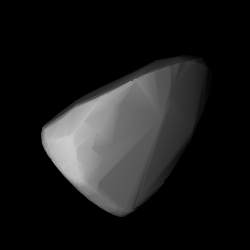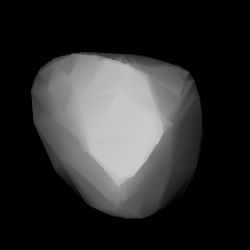Related Research Articles
515 Athalia, provisional designation 1903 ME, is a carbonaceous Themistian asteroid from the outer regions of the asteroid belt, approximately 40 kilometers in diameter. It was discovered on 20 September 1903, by German astronomer Max Wolf at the Heidelberg Observatory in southwest Germany. The asteroid was named after the ancient Judahite queen Athaliah.

1554 Yugoslavia, provisional designation 1940 RE, is a stony Eunomian asteroid from the middle region of the asteroid belt, approximately 16 kilometres (9.9 mi) in diameter. It was discovered by Serbian astronomer Milorad Protić at Belgrade Astronomical Observatory, Serbia, on 6 September 1940. It was named for the former country of Yugoslavia.

1132 Hollandia, provisional designation 1929 RB1, is a stony asteroid from the middle region of the asteroid belt, approximately 27 kilometers in diameter. It was discovered on 13 September 1929, by Dutch astronomer Hendrik van Gent at Leiden Southern Station, annex to the Johannesburg Observatory in South Africa. It was named for the region Holland in the Netherlands.

1165 Imprinetta, provisional designation 1930 HM, is a carbonaceous Meliboean asteroid from the outer regions of the asteroid belt, approximately 49 kilometers (30 mi) in diameter. It was discovered on 24 April 1930 by Dutch astronomer Hendrik van Gent at the Union Observatory in Johannesburg, South Africa. The asteroid was named after Imprinetta Gent, wife of the discoverer.
(9928) 1981 WE9, provisional designation 1981 WE9, is a stony Florian asteroid from the inner regions of the asteroid belt, approximately 3 kilometers in diameter. It was discovered on 16 November 1981, by astronomers at Perth Observatory in Bickley, Australia.
1567 Alikoski, provisional designation 1941 HN, is a rare-type carbonaceous asteroid from the outer region of the asteroid belt, approximately 67 kilometers in diameter. It was discovered on 22 April 1941, by Finnish astronomer Yrjö Väisälä at Turku Observatory in Southwest Finland. It was later named after Finnish astronomer Heikki Alikoski.

1294 Antwerpia (prov. designation: 1933 UB1) is a dark background asteroid from the central regions of the asteroid belt. It was discovered on 24 October 1933, by astronomer Eugène Delporte at the Royal Observatory of Belgium in Uccle. The carbonaceous C-type asteroid has a rotation period of 6.6 hours and measures approximately 35 kilometers (22 miles) in diameter. It was named for the Belgian city of Antwerp.
2038 Bistro, provisional designation 1973 WF, is a stony asteroid from the inner regions of the asteroid belt, approximately 12 kilometers in diameter. The asteroid was discovered on 24 November 1973, by Swiss astronomer Paul Wild at the Zimmerwald Observatory near Bern, Switzerland. It was named for the Bistro restaurant.
1271 Isergina, provisional designation 1931 TN, is a carbonaceous background asteroid from the outer regions of the asteroid belt, approximately 45 kilometers in diameter. It was discovered on 10 October 1931, by Soviet astronomer Grigory Neujmin at the Simeiz Observatory on the Crimean peninsula. The asteroid was named after Crimean physician and friend of the discoverer, Pyotr Isergin.
1384 Kniertje, provisional designation 1934 RX, is a dark Adeonian asteroid from the central regions of the asteroid belt, approximately 26 kilometers in diameter. It was discovered on 9 September 1934, by Dutch astronomer Hendrik van Gent at the Union Observatory in Johannesburg, South Africa. The asteroid was named after a character in the Dutch play Op Hoop van Zegen by Herman Heijermans.
2173 Maresjev, provisional designation 1974 QG1, is a dark background asteroid from the outer regions of the asteroid belt, approximately 28 kilometers (17 miles) in diameter. It was discovered on 22 August 1974, by Soviet–Ukrainian astronomer Lyudmila Zhuravleva at the Crimean Astrophysical Observatory in Nauchnij, on the Crimean peninsula. It was named for Soviet war veteran Alexey Maresyev. The assumed C-type asteroid has a tentative rotation period of 11.6 hours.
1264 Letaba, provisional designation 1933 HG, is a carbonaceous asteroid and possible tumbler from the background population of the outer asteroid belt, approximately 70 kilometers in diameter. It was discovered on 21 April 1933, by South African astronomer Cyril Jackson at the Union Observatory in Johannesburg. The asteroid was named for the Letaba River in eastern South Africa.
1303 Luthera, provisional designation 1928 FP, is a dark asteroid and the parent body of the Luthera family, located in the outermost regions of the asteroid belt. It measures approximately 90 kilometers in diameter. The asteroid was discovered on 16 March 1928, by astronomer Friedrich Schwassmann at the Bergedorf Observatory in Hamburg, Germany, and later named after German astronomer Robert Luther.
2090 Mizuho, provisional designation 1978 EA, is a stony asteroid from the outer region of the asteroid belt, approximately 18 kilometers in diameter.
1305 Phongolo, provisional designation 1928 OC, is a background asteroid from the outer regions of the asteroid belt, approximately 25 kilometers in diameter. It was discovered on 19 July 1928, by English astronomer Harry Edwin Wood at the Union Observatory in Johannesburg, South Africa. The asteroid was named for the South African Pongola River.
1258 Sicilia, provisional designation 1932 PG, is a dark background asteroid from the outer regions of the asteroid belt, approximately 44 kilometers in diameter. It was discovered on 8 August 1932, by astronomer Karl Reinmuth at the Heidelberg-Königstuhl State Observatory in southwest Germany. The asteroid was named after the Italian island of Sicily.
1266 Tone is a dark background asteroid from the outer regions of the asteroid belt, approximately 80 kilometers in diameter. Discovered by astronomer Okuro Oikawa at the Tokyo Observatory in 1927, it was assigned the provisional designation 1927 BD. The asteroid was later named after the Tone River, one of Japan's largest rivers.

2120 Tyumenia is a dark background asteroid, approximately 45 kilometers in diameter, located in the outer regions of the asteroid belt. It was discovered on 9 September 1967, by Soviet astronomer Tamara Smirnova at the Crimean Astrophysical Observatory in Nauchnyj, on the Crimean peninsula. The asteroid was named for the now Russian district of Tyumen Oblast in Western Siberia.
1296 Andrée, provisional designation 1933 WE, is a stony Nysian asteroid from the inner regions of the asteroid belt, approximately 25 kilometers in diameter. It was discovered on 25 November 1933, by French astronomer Louis Boyer at the North African Algiers Observatory, Algeria, and named after the discoverer's niece.
1708 Pólit, provisional designation 1929 XA, is a very dark asteroid from the outer region of the asteroid belt, approximately 29 kilometers in diameter. It was discovered on 30 November 1929, by Spanish astronomer of Catalan origin Josep Comas i Solà at the Fabra Observatory in Barcelona, and was later named after Catalan astronomer Isidre Pòlit i Boixareu.
References
- 1 2 3 4 "JPL Small-Body Database Browser: 1194 Aletta (1931 JG)" (2016-06-14 last obs.). Jet Propulsion Laboratory . Retrieved 1 February 2017.
- 1 2 3 4 Schmadel, Lutz D. (2007). "(1194) Aletta". Dictionary of Minor Planet Names – (1194) Aletta. Springer Berlin Heidelberg. p. 100. doi:10.1007/978-3-540-29925-7_1195. ISBN 978-3-540-00238-3.
- 1 2 3 4 5 6 "LCDB Data for (1194) Aletta". Asteroid Lightcurve Database (LCDB). Retrieved 1 February 2017.
- 1 2 3 Masiero, Joseph R.; Grav, T.; Mainzer, A. K.; Nugent, C. R.; Bauer, J. M.; Stevenson, R.; et al. (August 2014). "Main-belt Asteroids with WISE/NEOWISE: Near-infrared Albedos". The Astrophysical Journal. 791 (2): 11. arXiv: 1406.6645 . Bibcode:2014ApJ...791..121M. doi:10.1088/0004-637X/791/2/121 . Retrieved 1 February 2017.
- 1 2 3 4 Usui, Fumihiko; Kuroda, Daisuke; Müller, Thomas G.; Hasegawa, Sunao; Ishiguro, Masateru; Ootsubo, Takafumi; et al. (October 2011). "Asteroid Catalog Using Akari: AKARI/IRC Mid-Infrared Asteroid Survey". Publications of the Astronomical Society of Japan. 63 (5): 1117–1138. Bibcode:2011PASJ...63.1117U. doi:10.1093/pasj/63.5.1117. (online, AcuA catalog p. 153)
- 1 2 3 4 Mainzer, A.; Grav, T.; Masiero, J.; Hand, E.; Bauer, J.; Tholen, D.; et al. (November 2011). "NEOWISE Studies of Spectrophotometrically Classified Asteroids: Preliminary Results". The Astrophysical Journal. 741 (2): 25. arXiv: 1109.6407 . Bibcode:2011ApJ...741...90M. doi:10.1088/0004-637X/741/2/90.
- 1 2 3 4 Nugent, C. R.; Mainzer, A.; Masiero, J.; Bauer, J.; Cutri, R. M.; Grav, T.; et al. (December 2015). "NEOWISE Reactivation Mission Year One: Preliminary Asteroid Diameters and Albedos". The Astrophysical Journal. 814 (2): 13. arXiv: 1509.02522 . Bibcode:2015ApJ...814..117N. doi:10.1088/0004-637X/814/2/117 . Retrieved 1 February 2017.
- 1 2 3 4 Tedesco, E. F.; Noah, P. V.; Noah, M.; Price, S. D. (October 2004). "IRAS Minor Planet Survey V6.0". NASA Planetary Data System. 12: IRAS-A-FPA-3-RDR-IMPS-V6.0. Bibcode:2004PDSS...12.....T . Retrieved 22 October 2019.
- 1 2 Brinsfield, James W. (June 2008). "The Rotation Periods of 531 Zerlina, 1194 Aleta 1352 Wawel, 2005 Hencke, 2648 Owa, and 3509 Sanshui". The Minor Planet Bulletin. 35 (2): 86–87. Bibcode:2008MPBu...35...86B. ISSN 1052-8091 . Retrieved 1 February 2017.
- 1 2 Oey, Julian (October 2011). "Lightcurve Analysis of Asteroids from Leura and Kingsgrove Observatory for the Second Half of 2009 and 2010". The Minor Planet Bulletin. 38 (4): 221–223. Bibcode:2011MPBu...38..221O. ISSN 1052-8091 . Retrieved 1 February 2017.
- 1 2 3 Waszczak, Adam; Chang, Chan-Kao; Ofek, Eran O.; Laher, Russ; Masci, Frank; Levitan, David; et al. (September 2015). "Asteroid Light Curves from the Palomar Transient Factory Survey: Rotation Periods and Phase Functions from Sparse Photometry". The Astronomical Journal. 150 (3): 35. arXiv: 1504.04041 . Bibcode:2015AJ....150...75W. doi:10.1088/0004-6256/150/3/75 . Retrieved 1 February 2017.
- ↑ Faure, Gerard; Garrett, Lawrence (October 2009). "Suggested Revised H Values of Selected Asteroids: Report Number 4". The Minor Planet Bulletin. 36 (4): 140–143. Bibcode:2009MPBu...36..140F. ISSN 1052-8091 . Retrieved 1 February 2017.
- 1 2 "1194 Aletta (1931 JG)". Minor Planet Center. Retrieved 1 February 2017.